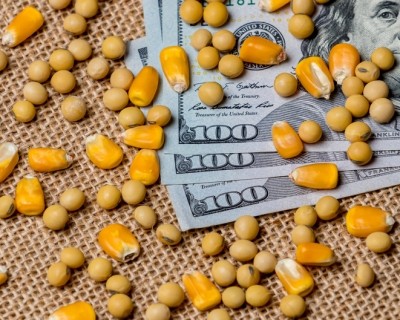Global grain surpluses are expected to persist to 2020, pending weather disruptions

Acreage expansions and improvements to yields in competing markets could undermine future US grain exports, finds a new report from CoBank - 2018-2020: Pressure on Grain and Farm Supply Sectors to Persist.
Tanner Ehmke, report author and manager of the Knowledge Exchange at CoBank, told FeedNavigator the demand for feed grains remains high though.
“Feed demand for livestock and poultry continues to grow as consumption of animal protein expands in the US and globally, and demand for biofuels is also strong and growing.
“That’s the good news – the downside for farmers is that there is an oversupply of grains that will continue to drag on prices in the near term.”
However, low grain prices are not necessarily detrimental to other members of the supply chain, he said. It can mean positive trends for grain elevators, grain storage facilities and the future market.
“For feed mills and end users, the grain supply situation looks to remain very positive in the year ahead. The abundance of feed grains in the US and throughout the world means their biggest cost will be very affordable for the foreseeable future.”
However, there are some potential areas for disruption as trade deals the US is involved are reviewed.
Looking forward, trade agreements renegotiation could add additional uncertainty and headwinds to the grain market, said Ehmke.
“Given the political situation right now with the current administration, it’s hard to say how things will pan out with our most important trade agreement, NAFTA,” he said. “We need open access to the Mexican and Canadian markets.”
That discussion comes after the US announced its exit from the Trans-Pacific Partnership [TPP], he said. “We’ve already backed out of TPP, which would have given us greater access into Asian markets,” he added.
“Meanwhile, FTAs continue to be negotiated outside of the US,” he said. “With the rest of the world pushing ahead with FTAs while we are backing out, that is definitely a headwind to the US since our competitors will be gaining market access while we are losing it.”
Pictures for corn, wheat and soy
The near-term and longer-view picture for corn is not as positive as it has been, said Ehmke in the report. Ethanol’s demand for corn is slowing and domestic feed demand is anticipated to plateau, he said.
Growth in production of the feed crop in the US likely hinges on the export market but challenges to expansion in that area include increasing competition from overseas, especially from Brazil, Argentina and Ukraine.
A major weather event that limits production is most likely to alter the current process of supply surplus and low corn prices, he said.
Wheat
US wheat producers also are expected to see headwinds from competition in the export market, he said. Many domestic wheat producers have been changing acres to other feed and food crops like corn and soybeans.
Long-term trends in that area also present challenges and wheat acreage in the US could continue to see decline, he said.
However, there are some positive notes in terms of the dollar value of wheat produced, which remains higher than the crop from countries like Russia, and there are some emerging markets demanding higher quality wheat where the US could potentially increase market share.
Soybeans
In soybeans, the US has ceded the title of largest exporter to Brazil, said Ehmke in his report. Production in Brazil also is expected to continue increasing to meet demand in China. As the country’s currency remains weak, the crop stays competitive on the global market.
Additionally, US producers may see more challenges from Brazil as infrastructure developments, like expanding paved roads and a new railroad line, continue, he said. However, ongoing growth of global demand for soybean meal for livestock feed and steady growth in biodiesel offer a potential upside.
There is no sign of a slowing demand for soybeans or soy-based feed ingredients, he said.
Farm supply sector
Additionally, members of the ag retail space also may be facing challenges in areas including reduction in the use of fertilizers and continued mergers in the seed and crop production spaces, he said. The sector also is starting to see changes from internet sales.
“The internet poses all kinds of potential disruption risk for the ag supply chain as it allows a platform for greater market transparency,” said Ehmke. “So conceivably, that means further market segmentation across all kind of value chains and further price pressure on retailers. That pressure will continue to grow on the supply chain to adapt in ways we may not be aware of currently, especially as broadband reaches deeper into Rural America.”










